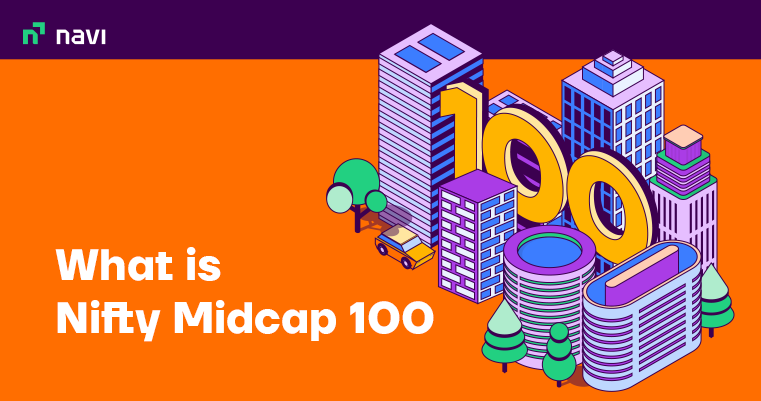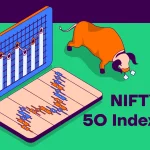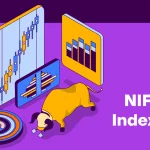Nifty Midcap 100: Sectors and Stocks List with Performance in 2023

What is Nifty Midcap 100?
The Nifty Midcap 100 index is a stock market index that represents 100 companies listed on the NSE (National Stock Exchange) ranked from 101 – 200 based on market capitalisation of ₹5,000 crore to ₹20,000 crore. This midcap index is used as a benchmark to track the performance of the companies of the mid-cap segment. The National Stock Exchange of India Limited (NSE), manages the index and provides a measure of mid-cap stocks in India.
Let’s understand the workings in detail.
Nifty Midcap 100 Index – At a Glance
The following table contains basic details of NSE midcap 100.
| Launch Date | July 18, 2005 |
| Base Date | January 1, 2003 |
| Base Value | ₹1,000 |
| No. of Constituents/companies | 100 |
| Methodology | Free Float Market Capitalisation |
| Calculation Frequency | Real-Time |
| Index Rebalancing | Semi-Annually |
| 1-Year Return | 2.39% |
| 5-Year Return | 9.16% |
| Since Inception | 20.28% |
How is the Nifty Midcap 100 Index Constructed?
The Nifty Midcap 100 Index is computed using free-float market capitalisation method, wherein the level of the index reflects the total free float market value of all. Based on free-float market cap calculations, Nifty generally accounts for 65% of the market’s overall free-float market value.
The NSE midcap 100 free-float index is designed in a way that it can track the movement of the midcap segment of the market. However, only stocks that are listed on the NSE and fulfil certain eligibility criteria are listed on this index. The Nifty Midcap 100 stocks list mostly includes stocks with strong liquidity.
What is the NIFTY Midcap 100 Methodology?
The Nifty Midcap 100 is calculated based on the following formula:
Free Float Market Capitalisation = Shares Outstanding x Price x Investable Weight Factor (IWF)
Index Value = [(Current Free Float Market Capitalisation) / (Base Free Float Market Capitalisation)] x (Base Index Value)
The number of shares that are accessible to the public for general trading is implied by the Investable Weight Factor. These shares are not owned by organisations or entities that have a controlling or strategic interest in the business. The proportion of shares held by investors in the public category is higher if the IWF increases.
Base Free Float Market Cap is the market cap derived on the Base Date, whereas Base Index Value is an arbitrary number that denotes the initial value of the index (in this case, it is 1,000). Nifty Midcap 100 index’s free float market capitalization is the total free-float market capitalization of the 100 firms included in the index. Meanwhile, the base period on which the base value was calculated is January 1, 2003.
Also Read
Eligibility Criteria for Selection of Constituent Stocks/Companies
According to the Nifty market indices methodology document published by the India Index Services & Products Limited, the following are the eligibility criteria to be fulfilled by the companies to become a part of the NIFTY Midcap 100 index:
- The NSE Midcap 100 index includes all companies from the Nifty Midcap 50. Constituents added in Nifty Midcap 50 which are not in Nifty Midcap 100 companies shall be included here.
- For remaining companies, securities will be included if rank based on average daily turnover is among the top 70 from constituents in Nifty Midcap 150.
- Securities will be excluded if rank based on the average daily turnover of existing constituents is below 130 among constituents in Nifty Midcap 150 or if a constituent is excluded from Nifty Midcap 150.
- Eligibility criteria for newly listed security are checked based on the data for a three-month period instead of a six-month period.
What are the Top 10 Companies Listed on Nifty 100 Midcap?
The top 10 companies in this list don’t change much. There are major ascends and descends among the remaining 90 participants. The top ten companies on Nifty Midcap 100 are listed below along with their weightage.
| Company Name | Weightage (%) |
| Max Healthcare Institute Ltd | 2.42 |
| AU Small Finance Bank Ltd | 2.20 |
| Federal Bank Ltd. | 2.11 |
| Tube Investments of India Ltd | 2.02 |
| Varun Beverages Ltd. | 1.99 |
| Trent Ltd. | 1.99 |
| Indian Hotels Co. Ltd | 1.97 |
| Shriram Finance Ltd | 1.94 |
| TVS Motor Company Ltd | 1.79 |
| Page Industries Ltd. | 1.79 |
What is the Weightage of Different Sectors in Nifty 100 Midcap?
The weightage of a sector can be generally said as important or the contribution of the sector. The Nifty 100 Midcap weightage chart is given below according to the sectors.
| Sector | Weightage (%) |
| Financial Services | 22.75 |
| Capital Goods | 11.35 |
| Automobile and Auto Components | 8.09 |
| Consumer Services | 6.51 |
| Information Technology | 5.87 |
| Oil, Gas & Consumable Fuels | 5.22 |
| Chemicals | 4.70 |
| Consumer Durables | 4.69 |
| Fast-Moving Consumer Goods | 4.57 |
| Metals & Mining | 3.79 |
| Realty | 2.15 |
| Textiles | 2.12 |
| Media, Entertainment & Publication | 1.84 |
| Telecommunication | 1.79 |
| Construction Materials | 1.72 |
| Services | 1.57 |
| Power | 1.29 |
Performance of NIFTY Midcap Index 100
The chart given below gives a detailed analysis of the returns.
| Time Period | Price Return (%) | Total Return (%) |
| QTD | -2.64 | -2.60 |
| YTD | -2.64 | -2.60 |
| 1 year | 1.33 | 2.39 |
| 5 years | 8.10 | 9.16 |
| Since inception | 18.57 | 20.28 |
Also Read
What is the Difference between NIFTY Midcap 100 and Midcap 150?
Although both indices belong to the midcap range, there are some basic differences between the two of them. Read the table below to know about the differences between NSE midcap 100 and Midcap 150.
| Nifty Midcap 100 | Nifty Midcap 150 |
| It is a list of the top 100 midcap companies that are included on the Nifty 500 index. | It is a list of all midcap companies that are included in the Nifty 500. |
| It represents companies ranking from 101st place to 200th place on the Nifty 500 index. | It represents companies ranking from 101st place to 250th place on Nifty 500. |
| The base date for the Nifty midcap 100 is July 1, 2003. | The base date is April 1, 2005. |
| As of January 31st, 2023, the dividend yield was 1.31. | As of January 31st, 2023, the dividend yield was 1.23 |
What is the Difference between NIFTY Midcap 100 and Midcap 50?
Both NSE midcap 100 and midcap 50 belong to the midcap range but the differences that are present between the two are given below.
| Nifty Midcap 100 | Nifty Midcap 50 |
| It is a list of the top 100 midcap companies that are included on the Nifty 500 index. | It is a list of the top 50 midcap companies out of all midcap companies on Nifty 500 index. |
| It represents companies ranking from 101st place to 200th place on the Nifty 500 index. | It includes companies ranking from 101st-150th place on the Nifty 500 index. |
| Base date for Nifty midcap 100 is July 1, 2003. | Base date for Nifty midcap 50 is January 1, 2004. |
| As of January 31st, 2023, dividend yield was 1.31. | As of January 31st, 2023, dividend yield was 1.48. |
| Since its inception, the total return of the Nifty midcap 100 has been 20.28%. | Since its inception, the total return of the Index has been 13.44% |
How to Invest in the Nifty Midcap 100 Index?
You can invest in Nifty Midcap 100 index fund via AMC or a third-party aggregator to capture the potential of the NSE midcap 100 index.
Investing via AMC
- Step 1: Go to the official website of AMC or download their app
- Step 2: From the mutual fund section, select a Nifty Midcap 100 index fund on the basis of expense ratio, tracking error, etc.
- Step 3: Complete your KYC and start investing via SIP or in lump sum
Investing via Aggregator
- Step 1: Go to the aggregator’s website or download their app
- Step 2: Select a Nifty Midcap 100 index fund based on cost, tracking error, etc.
- Step 3: Complete your KYC and start investing
Final Word
Nifty Midcap 100 can be used for a variety of purposes such as benchmarking fund portfolios, launching of index funds, ETFs and structured products. Companies in the midcap range have a huge potential to grow – some of them hold the potential to become large cap companies someday.
Planning to invest in the mid-cap equity market? Start investing with Navi Mutual Fund. Enjoy a host of benefits – access to a wide range of schemes, low-cost funds and minimal investment capital requirement – you can invest with ₹10 in Navi Mutual Fund schemes.
FAQs
Nifty Midcap 100 index is a total of the top 100 best-performing midcap companies in India. They are decided based on free-float market capitalisation.
The momentum score of midcap 100 stocks is 40.9.
The market cap of nifty midcap 100 companies is ₹33,11,811.11 crore as of February 8, 2023.
The return of the Nifty 100 Midcap index since inception is 20.28%.
The one-year return of nifty midcap 100 companies is 2.39%.
The five-year return of the Nifty Midcap 100 is 9.16%.

Customer’s Feedback
No comments found.10 Best Demat Accounts in India for Beginners in 2023
Creation of Demat accounts revolutionised the way trades were conducted at the stock exchanges. It... Read More »10 Best SIP Plans for 1000 Per Month in India 2023
Systematic Investment Plan (SIP) is an investment style or route with which you can invest a fixed ... Read More »How to Invest in Mutual Funds in India – Easy Steps
Mutual funds can be an excellent way to diversify your portfolio and gain exposure to a wide range ... Read More »20 Best Nifty 50 Index Funds in India to Invest in April 2023
What is the Nifty 50 Index Fund? Nifty 50 index funds are a type of passively-managed equi... Read More »Asset Management Company (AMC) – Types and Benefits
What is an Asset Management Company (AMC)? Asset Management Company or AMC is a financial ... Read More »10 Best Gold Mutual Funds to Invest in India (April 2023)
Gold Mutual Funds are funds that invest in gold and gold-related assets such as bullion, coin... Read More »20 Best Flexi Cap Mutual Funds to Invest in India 2023
Flexi-cap funds are mutual fund schemes that aim to invest in stocks of companies across market cap... Read More »Best SIP Plans for 15 years – Top 10 SIP Plans to Invest in India 2023
A systematic investment plan (SIP) could be a convenient mode or style of investing in mutual funds... Read More »10 Best SIP Plans for 1 year Investment in India 2023
There has been a massive surge in SIP or Systematic Investment Plan investors in recent years. As p... Read More »10 Best SIP Plan for 3 Years in India to Invest in 2023
SIP or Systematic Investment Plan helps bring investment discipline in an investor’s life. It’s... Read More »10 Best SIP Plan for 10 years India in 2023 – Returns and Performance
Ask any beginner mutual fund investor and most of them would tell you that their preferred mode of ... Read More »10 Best SIP Plans for 5 years in India to Invest in 2023
Systematic Investment Plan (SIP) could be an effective investment mode if you want to invest a fixe... Read More »Top 10 Chit Fund Schemes in India in 2023
Chit funds are one of the most popular return-generating saving schemes in India. It is a financial... Read More »10 Best Gold ETFs in India to Invest in April 2023
Gold ETFs or Gold Exchange Traded Funds are passively managed funds that track the price of physica... Read More »10 Best Demat Accounts in India for Beginners in 2023
Creation of Demat accounts revolutionised the way trades were conducted at the stock exchanges. It... Read More »20 Best Index Funds to Invest in India in April 2023
What is an Index Fund? An index fund is a type of mutual fund or exchange-traded fund (ETF) that... Read More »Best Arbitrage Mutual Funds to Invest in India in April 2023
Arbitrage funds are hybrid mutual fund schemes that aim to make low-risk profits by buying and sell... Read More »10 Best SIP Plans in India to Invest in April 2023
What is SIP? SIP or Systematic Investment Plan is a method of investing a fixed amount in ... Read More »10 Best Corporate Bond Funds in India to Invest in April 2023
Corporate bond funds are debt funds that invest at least 80% of the investment corpus in companies ... Read More »10 Best Bank for Savings Account in India [Highest Interest Rate 2023]
Savings account is a type of financial instrument offered by several banks. It lets you safely depo... Read More »























